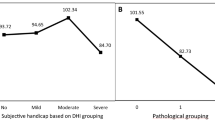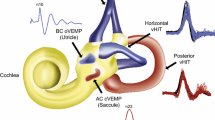Abstract
Purpose
Video head impulse testing (vHIT) is a relatively new technology enabling evaluation of vestibular function. The aim of this study was to compare the test results from two separate vHIT systems in a group of patients diagnosed with a unilateral vestibular schwannoma (VS) with regards to sensitivity, specificity and inter-examiner differences.
Methods
Forty-two patients were examined with two separate vHIT systems: EyeSeeCam® (system A) and ICS Impulse® (system B), by one of two examiners. All six semicircular canals (SCCs) were tested under standardized conditions, and strict criteria were set up for post-test interpretation.
Results
With the majority of test parameters, the two test systems were in agreement. Vestibular deficits were found in 40.5% (system A) to 45% (system B) of patients with a VS on the tested side; corresponding to a positive predictive value (PPV) of 86.4% (system B) to 94.4% (system A). The specificity was 97.6% for system A and 92.9% for system B. An overall agreement between the two vHIT systems measured as kappa was computed to be 0.61. There were no significant inter-examiner differences. When testing the vertical SCCs, a tendency of too high mean gain values was seen with system A but not with system B.
Conclusion
In patients with unilateral VS, vHIT is a test with moderate sensitivity and high specificity in regard to identification of a vestibular deficit. There were no significant differences in test results between the two vHIT systems.


Similar content being viewed by others
Data availability
All data were stored and registered in the electronic data capture systems provided by the manufacturers and stored in the Regional Electronic Data Record Systems provided by the University Hospital.
References
Curthoys IS et al (2014) The video head impulse test (vHIT). In: Balance function assessment and management, 2nd edn. Plural Publishing, San Diego, Ca, pp 391–430
Walther LE (2017) Current diagnostic procedures for diagnosing vertigo and dizziness. GMS Curr Top Otorhinolaryngol Head Neck Surg 16:02. https://doi.org/10.3205/cto000141
Taylor RL, Kong J, Flanagan S et al (2015) Prevalence of vestibular dysfunction in patients with vestibular schwannoma using video head-impulses and vestibular-evoked potentials. J Neurol 262(5):1228–1237. https://doi.org/10.1007/s00415-015-7697-4
Halmagyi GM, Chen L, MacDougall HG, Weber KP, McGarvie LA, Curthoys IS (2017) The video head impulse test. Front Neurol. https://doi.org/10.3389/fneur.2017.00258
McGarvie LA, MacDougall HG, Halmagyi GM, Burgess AM, Weber KP, Curthoys IS (2015) The video head impulse test (vHIT) of semicircular canal function—age-dependent normative values of VOR gain in healthy subjects. Front Neurol 6(JUL):1–18. https://doi.org/10.3389/fneur.2015.00154
Welgampola MS, Akdal G, Halmagyi GM (2017) Neuro-otology- some recent clinical advances. J Neurol 264(1):188–203. https://doi.org/10.1007/s00415-016-8266-1
Korsager LEH, Schmidt JH, Faber C, Wanscher JH (2016) Reliability and comparison of gain values with occurrence of saccades in the EyeSeeCam video head impulse test (vHIT). Eur Arch Oto-Rhino-Laryngol 273(12):4273–4279. https://doi.org/10.1007/s00405-016-4183-2
Alhabib SF, Saliba I (2017) Video head impulse test: a review of the literature. Eur Arch Oto-Rhino-Laryngol 274(3):1215–1222. https://doi.org/10.1007/s00405-016-4157-4
Cleworth TW, Carpenter MG, Honegger F, Allum JHJ (2017) Differences in head impulse test results due to analysis techniques. J Vestib Res Equilib Orientat 27(2–3):163–172. https://doi.org/10.3233/VES-170614
Abrahamsen ER, Christensen A, Hougaard DD (2018) Intra- and interexaminer variability of two separate video head impulse test systems assessing all six semicircular canals. Otol Neurotol. 39(2):e113–e122. https://doi.org/10.1097/mao.0000000000001665
Janky KL, Patterson JN, Shepard NT, Thomas MLA, Honaker JA (2017) Effects of device on video head impulse test (vHIT) gain. J Am Acad Audiol 28(9):778–785. https://doi.org/10.3766/jaaa.16138
Khrais T, Romano G, Sanna M (2017) Nerve origin of vestibular schwannoma: a prospective study. J Laryngol Otol. https://doi.org/10.1017/S0022215107001028
Stangerup S-E, Caye-Thomasen P (2012) Epidemiology and natural history of vestibular schwannomas. Otolaryngol Clin North Am 45(2):257–268. https://doi.org/10.1016/j.otc.2011.12.008
Sass HCR, West N, Møller MN, Cayé-Thomasen P (2018) Udredning og behandling af vestibularisschwannomer. Ugeskr Læger 2–4. https://ugeskriftet.dk/files/scientific_article_files/2018-09/v02180131_0.pdf. Accessed 6 Nov 2018
Humphriss RL, Baguley DM, Axon PR, Moffat DA (2006) Preoperative audiovestibular handicap in patients with vestibular schwannoma. Skull Base 16(4):193–200. https://doi.org/10.1055/s-2006-950388
Halliday J (2017) An update on the treatment of vestibular schwannoma. Expert Rev Neurother 60(2):131–140. https://doi.org/10.1016/S2173-5735(09)70116-4
Sahyouni R, Moshtaghi O, Haidar YM et al (2017) Vertigo in vestibular schwannoma patients due to other pathologies. Otol Neurotol. https://doi.org/10.1097/MAO.0000000000001567
Møller MN, Hansen S, Caye-Thomasen P (2015) Peripheral vestibular system disease in vestibular schwannomas. Otol Neurotol 36(9):1547–1553. https://doi.org/10.1097/MAO.0000000000000846
Kjærsgaard JB, Szeremet M, Hougaard DD (2019) Vestibular deficits correlating to dizziness handicap inventory score, hearing loss, and tumor size in a danish cohort of vestibular schwannoma patients. Otol Neurotol 40(6):813–819. https://doi.org/10.1097/MAO.0000000000002236
Kanzaki J, Tos M, Sanna M, Moffat DA, Monsell EM, Berliner KI (2003) New and modified reporting systems from the consensus meeting on systems for reporting results in vestibular schwannoma. Otol Neurotol 24:642–648 (discussion 648-9)
Sun X, Xu W (2014) Fast implementation of delong’s algorithm for comparing the areas under correlated receiver operating characteristic curves. IEEE Signal Process Lett 21(11):1389–1393. https://doi.org/10.1109/LSP.2014.2337313
(2018) R: a language and environment for statistical computing. R foundation for statistical computing, R Core Team, Vienna. https://www.r-project.org/. Accessed 2 Feb 2019
Tranter-Entwistle I, Dawes P, Darlington CL, Smith PF, Cutfield N (2016) Video head impulse in comparison to caloric testing in unilateral vestibular schwannoma. Acta Otolaryngol 136(11):1110–1114. https://doi.org/10.1080/00016489.2016.1185540
Batuecas-Caletrio A, Santa Cruz-Ruiz S, Muñoz-Herrera A, Perez-Fernandez N (2015) The map of dizziness in vestibular schwannoma. Laryngoscope 125(12):2784–2789. https://doi.org/10.1002/lary.25402
West N, Sass H, Klokker M, Cayé-Thomasen P (2020) Video head impulse test results in patients with a vestibular schwannoma—sensitivity and correlation with other vestibular system function tests, hearing acuity, and tumor size. Otol Neurotol. https://doi.org/10.1097/MAO.0000000000002600
Rey-Martinez J, Burgess AM, Curthoys IS (2018) Enhanced vestibulo-ocular reflex responses on vHIT. Is it a casual finding or a sign of vestibular dysfunction? Front Neurol 9:866
Funding
No funding.
Author information
Authors and Affiliations
Corresponding author
Ethics declarations
Conflict of interest
The authors declare no conflicts of interest.
Ethical approval
Complete vHIT testing and fulfillment of the Dizziness Handicap Questionnaire is part the standard clinical evaluation of patients diagnosed with a vestibular schwannoma and both types of vHIT equipment used in this study are already approved for clinical testing. Furthermore, no patients had to undergo randomization to additional treatments or examinations. Therefore, a formal application to the North Denmark Region Committee on Research Ethics was not deemed necessary.
Consent to participate
All subjects were thoroughly informed about the vHIT testing prior to the test.
Additional information
Publisher's Note
Springer Nature remains neutral with regard to jurisdictional claims in published maps and institutional affiliations.
Electronic supplementary material
Below is the link to the electronic supplementary material.
Rights and permissions
About this article
Cite this article
Aalling, M., Skals, R.K., Abrahamsen, E.R. et al. Comparison of test results from two separate video head impulse test systems in a cohort of patients diagnosed with a unilateral vestibular schwannoma. Eur Arch Otorhinolaryngol 277, 3185–3193 (2020). https://doi.org/10.1007/s00405-020-06116-2
Received:
Accepted:
Published:
Issue Date:
DOI: https://doi.org/10.1007/s00405-020-06116-2




